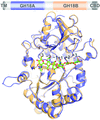issue contents
January 2018 issue

Cover illustration: A DNA structural alphabet provides new insight into DNA flexibility (Schneider et al., p. 52). The dinucleotide structures of 60 000 DNA steps from sequentially nonredundant crystal structures have been classified and an automated protocol assigning 44 distinct structural (conformational) classes called NtC (for Nucleotide Conformers) has been developed. The NtC were assembled into the DNA structural alphabet CANA (Conformational Alphabet of Nucleic Acids) and the projection of CANA onto the graphical representation of the molecular structure proposed. Examples of the graphical representation of the CANA letters assigned to some DNA structures are shown here.
research papers
Open  access
access
 access
accessStructure of Rubisco from Arabidopsis thaliana in complex with 2-carboxyarabinitol-1,5-bisphosphate
The first crystal structure of Rubisco from A. thaliana is described and is compared with all other form I Rubisco crystal structures. This new structure is used to discuss the catalytic differences that could be conferred by alternative Rubisco small-subunit isoforms, and the potential benefit of differential expression of such isoforms on photosynthetic carbon assimilation in land plants.
PDB reference: Rubisco from Arabidopsis thaliana, 5iu0
A structural change in a MamC-derived magnetite-binding peptide causes defects in its function during in vitro magnetite synthesis. Structural characterizations were conducted using X-ray crystallography and SAXS, while ITC and in vitro iron precipitation were used for functional studies.
Open  access
access
 access
accessThe crystal structure of the major outer membrane protein U (OmpU) from Vibrio cholerae has been determined, which exhibits distinct structural features from other structurally characterized porins and provides the structural basis for the bacterial invasion and phage recognition.
PDB reference: OmpU, 5onu
Open  access
access
 access
accessMultiple catalytic domains in one chitinase have been shown to function synergistically during chitin degradation. Here, using biochemical and structural characterization, an insect chitinase was revealed to have two nonsynergistic catalytic domains, which may be involved in chitin synthesis instead of chitin degradation.
The structure of the folate-binding (Fol) module of Thermus thermophilus methionine synthase (MS) is described in the presence and absence of the methyltetrahydrofolate substrate. It is found that the methyltetrahydrofolate-binding environment is similar to those of previously described folate-dependent methyltransferases, highlighting the conserved role of this module in binding and perhaps activating the methyltetrahydrofolate substrate. Additionally, the structures reveal a significant difference in the C-terminal region of the T. thermophilus MS Fol module compared with other folate-binding or pterin-binding proteins.
Open  access
access
 access
accessLarge deformations of the DNA double helix induced by interactions with proteins and small molecules are necessary to support the biological function of DNA. Here, the software tools available at https://dnatco.org that classify the dinucleotide building blocks into 44 distinct structural classes and 11 letters of a first DNA structural alphabet are presented and are used to analyze several prototypical DNA structures.
addenda and errata
Free 



 journal menu
journal menu























